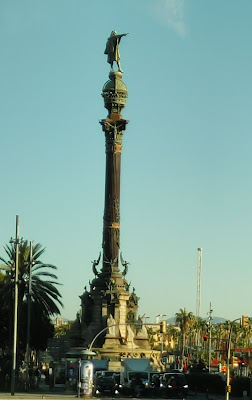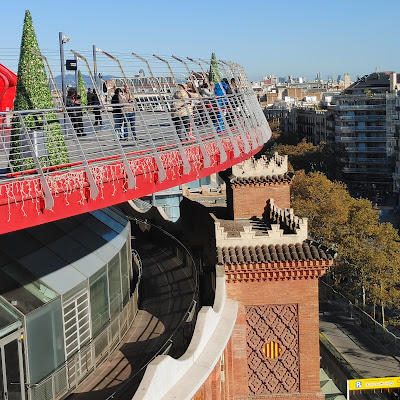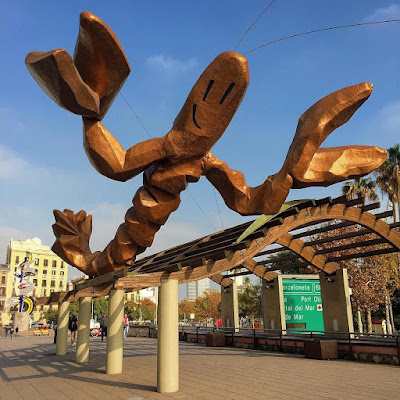 |
| A full moon over Barcelona greets us on our disembarkation day. |
 |
| Since we will be staying in Barcelona for two nights, our day starts with a 1/2 day tour of Barcelona. |
 |
| The cruise ship docks are out on a man-made wharf so we have to cross this bridge to get to the mainland. |
 |
| Looks like the moon is still giving us a show. |
 |
| Must be laundry day. Barcelona is the heart of Catalonia, a province of Spain that has many residents that wish to separate from Spain. They have their own language, Catalan. |
 |
| David and Goliath is an abstract statue by Antoni Llena i Font inspired by the Somarrostro shanty town that occupied the nearby beach from 1882 until it was torn down in 1966. The statue consists of a large white metal rectangle supported by three thin stainless-steel legs. The rectangle represents laundry blowing in the wind and symbolizes life in the shanty town. Four slots are cut in the sheet, creating a ghost-like face that bears witness to the loss and reminds us that, in this case, Goliath won the battle. |
 |
| I never found any information about the ball. It, and the Fish, are on top of the Casino Barcelona. At this point we are in Barceloneta, a town with streets between each building. |
 |
| The Hotel Arts Barcelona is getting a 60-million-euro update. It looks like a lift system for shipping containers has been added to simplify the work. |
 |
| From this spot we could see the Glory Facade of the Sagrada Familia. More on that in the next post. |
 |
| I didn't find any information on this statue. |
 |
| The winter garden is a pavilion made of cast iron and glass constructed in 1888 for the World Exposition. |
 |
| The first place we exited the bus was at the Arc de Triomf in Ciudadela Park, another structure built for the 1888 Exhibition. |
 |
| Interesting streetlights line the promenade. |
 |
| You can see the streetlights in this photo. |
 |
| Just some interesting buildings. |
 |
| Arc de Triomf from the north. |
 |
| Northwest view |
 |
| South view |
 |
| This Catalan art nouveau style building houses the Superior Court of Justice of Catalonia. |
 |
| Ornate 1888 Corinthian column topped with a statue of Christopher Columbus pointing toward America. |
 |
| Aduana - Old Customs House |
 |
| This sculpture is called Onades and was created by Andreu Alfaro |
 |
| The Cable Car connects the San Sebastián tower in Barceloneta with the Miramar station, located on the Montjuic mountain. |
 |
| Christopher Columbus was still pointing to the Americans when we went back by him. |
 |
| You can ride cable cars up Montjuic to the Castle |
 |
| Another way to get to Montjuic is to ride a bus to the start of the funicular, then take the funicular almost all the way up to the Castle. |
 |
| We stopped at the Museu Nacional d'Art de Catalunya (National Museum of Catalan Art) |
 |
| Although not the Montjuic Castle, it is a Palatial, hilltop museum for 11th- to 20th-century Catalan art plus important Romanesque collection. |
 |
| But we weren't there for the art, we were there for the views. From in front of the museum, we looked across the city to the mountain beyond. |
 |
| Closer to us we could see the hotel where we would stay for two nights, Nobu Hotel. |
 |
| Looking northeast over the city, we could see the Sagrada Familia, Anton Gaudi's most famous creation. |
 |
| The Sagrada Familia is still under construction and is something you will learn more about in the next post. |
 |
| We're almost done looking at the view so we walked back across the front of the museum. |
 |
| Had to get one more photo taken, this time to the west. This shows the statues in front of the museum. |
 |
| Musical and entertainment events are held at the historic Poble Espanyol (Spanish Town). |
 |
| CaixaForum transformed the old wall of the Metallurgy Palace, part of Fira Montjuïc congress hall beside the arts center, into a vertical garden in the middle of the city. |
 |
| The new green space includes 22,000 plants from 40 different species and 15 suspended trees of nine varieties. |
 |
| During the drive to our hotel, the bus drove past the Fountain of the Three Seas. It must be spectacular when this, the Magic fountain, and waterfall are all working. |
 |
| We passed by the bullring turned shopping center. They have added a rooftop ring of restaurants surrounded by a walkway. |
 |
| Off to the left a tower is attached to the walkway on top of the shopping center. After checking into our hotel, we walked back to the shopping center and ate at a roof-top restaurant. |
 |
| I think mine was vegetarian. |
 |
| After eating, we stepped out to the tower for some photos. We looked back at the art museum we took photos of earlier. |
 |
| I know I had a photo of this sculpture called Woman and Bird from the day we boarded the cruise ship, but this is a view from a different side. |
 |
| Looking back at the rooftop terrace added to the bullring. |
 |
| There are five levels of stores, a theater and other entertainment venues. |
 |
| Right in the center of the ground floor is this ring where colored dots move as you step though each area. A couple people are having fun here. |
 |
| I'm not sure what this road led to, underground parking? |
 |
| The bicycle lane between the sidewalk and the road was quite busy so you had to make sure to look both ways before crossing. |
 |
| Our room at the Hotel Nobu. |
 |
| The glass jar looking things on the stand are light fixtures. There's a radio also |
 |
| Our windows looked to the north. |
 |
| There's a table and chair behind all our luggage. |
 |
| Looking back at the room's door. |
 |
| Light fixture in headboard. |
 |
| There was a sheet of clear glass between the shower and the toilet. The water splattered out toward the sinks when you took a shower. |
































No comments:
Post a Comment